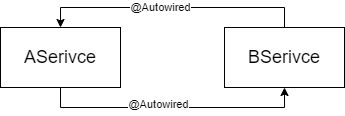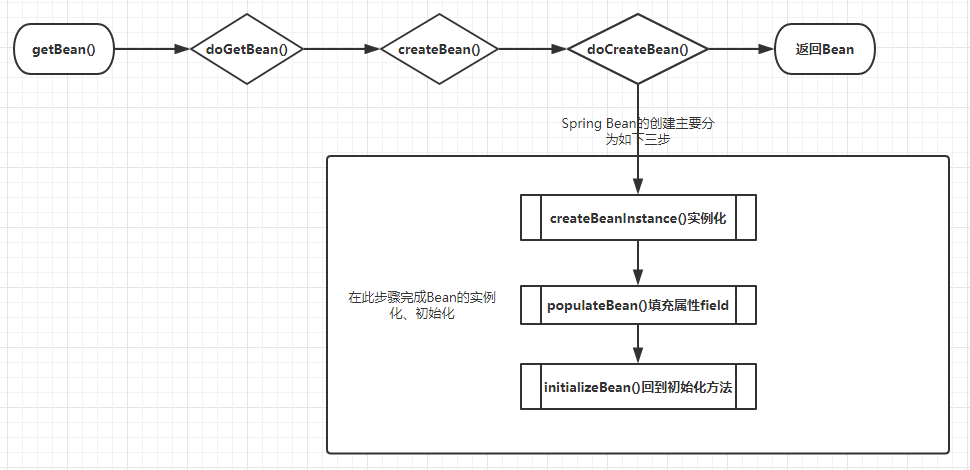参考 https://www.freesion.com/article/9009504573/
参考 https://blog.csdn.net/JAVA88866/article/details/124709836
最近公司项目在部署上线的时候遇到循环依赖问题,小朋友就很奇怪本地为啥可以部署上线就不可以。在解决这个问题的时候就又梳理了下Spring的三级缓存.
首先解决小朋友遇到的问题原因,是因为Spring在加载Bean的时候是随机的,导致Bean初始化顺序与本地不一样.

有循环依赖的情况,最好的办法就是去重构代码说明逻辑有问题.其次在开启Spring 三级缓存,Spring已经默认是关闭的.
spring.main.allow-circular-references=true

# 了解spring三级缓存的时候需要先知道Spring Bean创建流程.

- Spring 解析Bean 为 BeanDefinition
- 遍历BeanDefinition进行Bean对象创建
- doGetBean 进行获取Bean,从(一二三)缓存中获取
- 获取不到时,进入createBean方法创建bean
- doCreateBean 执行创建bean
- createBeanInstance 在堆中创建该bean,
这时bean的属性还都为null - 注意,这时候会根据是否允许循环依赖,如果开启就把当前bean放入三级缓存中(addSingletonFactory > getEarlyBeanReference(生成代理对象)).
- populateBean 注入属性,如果依赖其他bean的时会调用
getSingleton > doGetBean走2.2步骤 . 如果找到就注入成功.这时候这里的属性已经有值了.__循环依赖就是这里发生的__ - initializeBean 主要执行
BeanPostProcessor处理器 10 其他操作,验证循环依赖等,暴露bean.
# Spring 三级缓存
在Spring的DefaultSingletonBeanRegistry类中内部维护了三个Map,也就是我们通常说的三级缓存。
- 一级缓存(singletonObjects), Cache of singleton objects bean name --> bean instance。 存放完整对象。
- 二级缓存(earlySingletonObjects), Cache of early singleton objects bean name --> bean instance 提前曝光的BEAN缓存。 存放半成品对象。
- 三级缓存(singletonFactories), Cache of singleton factories bean name --> ObjectFactory。需要的对象被代理时,就必须使用三级缓存(否则二级就够了)。解决循环依赖中存在aop的问题 存放 lambda 表达式和对象名称的映射。
public class DefaultSingletonBeanRegistry extends SimpleAliasRegistry implements SingletonBeanRegistry {
...
// 从上至下 分表代表这“三级缓存”
private final Map<String, Object> singletonObjects = new ConcurrentHashMap<>(256); //一级缓存
private final Map<String, Object> earlySingletonObjects = new HashMap<>(16); // 二级缓存
private final Map<String, ObjectFactory<?>> singletonFactories = new HashMap<>(16); // 三级缓存
...
/** Names of beans that are currently in creation. */
// 这个缓存也十分重要:它表示bean创建过程中都会在里面呆着~
// 它在Bean开始创建时放值,创建完成时会将其移出~
private final Set<String> singletonsCurrentlyInCreation = Collections.newSetFromMap(new ConcurrentHashMap<>(16));
/** Names of beans that have already been created at least once. */
// 当这个Bean被创建完成后,会标记为这个 注意:这里是set集合 不会重复
// 至少被创建了一次的 都会放进这里~~~~
private final Set<String> alreadyCreated = Collections.newSetFromMap(new ConcurrentHashMap<>(256));
/** Bean移动到 一级缓存中,情况其他缓存中的数据 */
protected void addSingleton(String beanName, Object singletonObject) {
synchronized (this.singletonObjects) {
this.singletonObjects.put(beanName, singletonObject);
this.singletonFactories.remove(beanName);
this.earlySingletonObjects.remove(beanName);
this.registeredSingletons.add(beanName);
}
}
/** 添加Bean到三级缓存中 */
protected void addSingletonFactory(String beanName, ObjectFactory<?> singletonFactory) {
Assert.notNull(singletonFactory, "Singleton factory must not be null");
synchronized (this.singletonObjects) {
if (!this.singletonObjects.containsKey(beanName)) {
this.singletonFactories.put(beanName, singletonFactory);
this.earlySingletonObjects.remove(beanName);
this.registeredSingletons.add(beanName);
}
}
}
/** 获得Bean, 注意如果在三级缓存中获取到的时候就把三级缓存的bean移动到二级缓存中 */
protected Object getSingleton(String beanName, boolean allowEarlyReference) {
// Quick check for existing instance without full singleton lock
Object singletonObject = this.singletonObjects.get(beanName);
if (singletonObject == null && isSingletonCurrentlyInCreation(beanName)) {
singletonObject = this.earlySingletonObjects.get(beanName);
if (singletonObject == null && allowEarlyReference) {
synchronized (this.singletonObjects) {
// Consistent creation of early reference within full singleton lock
singletonObject = this.singletonObjects.get(beanName);
if (singletonObject == null) {
singletonObject = this.earlySingletonObjects.get(beanName);
if (singletonObject == null) {
ObjectFactory<?> singletonFactory = this.singletonFactories.get(beanName);
// 注意如果在三级缓存中获取到的时候就把三级缓存的bean移动到二级缓存中
if (singletonFactory != null) {
singletonObject = singletonFactory.getObject();
this.earlySingletonObjects.put(beanName, singletonObject);
this.singletonFactories.remove(beanName);
}
}
}
}
}
}
return singletonObject;
}
}
2
3
4
5
6
7
8
9
10
11
12
13
14
15
16
17
18
19
20
21
22
23
24
25
26
27
28
29
30
31
32
33
34
35
36
37
38
39
40
41
42
43
44
45
46
47
48
49
50
51
52
53
54
55
56
57
58
59
60
61
62
63
64
65
66
67
68
# 具体是怎么解决循环依赖的那?
Spring 二级缓存提前暴露的并不是实例化的Bean,而是将Bean包装起来ObjectFactory. 为什么要这么做? 实际上Spring一开始并不知道Bean是否有循环依赖,没有依赖的情况下都可以正常的填充属性对象,如果有依赖Spring不得不为其提前创建代理对象,代理对象对执行getObject方法获取到Bean.
Spring需要三级缓存的目的是为了延迟代理对象的创建,如果没有依赖循环的话,那么就不需要为其提前创建代理,可以将它延迟到初始化完成之后再创建。
# 为什么 Spring 不选择二级缓存,而要额外多添加一层缓存呢?
如果Spring 选择二级缓存来解决循环依赖的话,那么就意味着所有 Bean 都需要在实例化完成之后就立马为其创建代理,而Spring 的设计原则是在 Bean 初始化完成之后才为其创建代理。所以,Spring 选择了三级缓存。但是因为循环依赖的出现,导致了 Spring 不得不提前去创建代理,因为如果不提前创建代理对象,那么注入的就是原始对象,这样就会产生错误。
# 注意主bean对象通过构造函数注入所依赖bean对象时会出现异常
主要是主bean对象通过构造函数注入所依赖bean对象时,无法创建该所依赖的bean对象,获取该所依赖bean对象的引用。因为如下代码所示。 创建主bean对象,调用顺序为:
- 调用构造函数
- 放到三级缓存
- 属性赋值。其中调用构造函数时会触发所依赖的bean对象的创建。
createBeanInstance是调用构造函数创建主bean对象,在里面会注入构造函数中所依赖的bean,而此时并没有执行到addSingletonFactory方法来添加主bean对象的创建工厂到三级缓存singletonFactories中。故在createBeanInstance内部,注入和创建该主bean对象时,如果在构造函数中存在对其他bean对象的依赖,并且该bean对象也存在对主bean对象的依赖,则会出现循环依赖问题.
